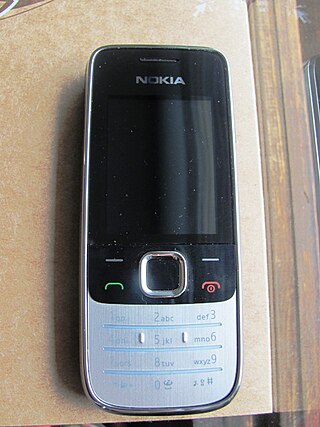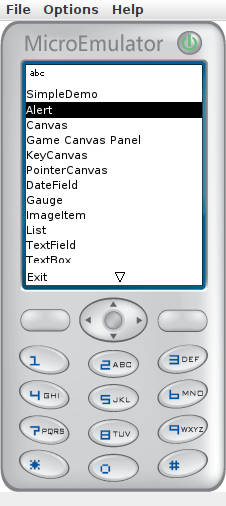Related Research Articles

OSGi is an open specification and open source project under the Eclipse Foundation.
Jakarta Enterprise Beans is one of several Java APIs for modular construction of enterprise software. EJB is a server-side software component that encapsulates business logic of an application. An EJB web container provides a runtime environment for web related software components, including computer security, Java servlet lifecycle management, transaction processing, and other web services. The EJB specification is a subset of the Java EE specification.
Java Platform, Micro Edition or Java ME is a computing platform for development and deployment of portable code for embedded and mobile devices. Java ME was formerly known as Java 2 Platform, Micro Edition or J2ME.
Java Platform, Standard Edition is a computing platform for development and deployment of portable code for desktop and server environments. Java SE was formerly known as Java 2 Platform, Standard Edition (J2SE).
A MIDlet is an application that uses the Mobile Information Device Profile (MIDP) of the Connected Limited Device Configuration (CLDC) for the Java ME environment. Typical applications include games running on mobile devices such as smartphones with J2ME support and feature phones which have small graphical displays, simple numeric keypad interfaces and limited network access over HTTP.
DoJa profile is a Java application environment specification for DoCoMo's i-mode mobile phone.
Mobile Information Device Profile (MIDP) is a specification published for the use of Java on embedded devices such as mobile phones and PDAs. MIDP is part of the Java Platform, Micro Edition framework and sits on top of Connected Limited Device Configuration (CLDC), a set of lower level programming interfaces. MIDP was developed under the Java Community Process. The first MIDP devices were launched in April 2001.
The Connected Device Configuration (CDC) is a specification of a framework for Java ME applications describing the basic set of libraries and virtual-machine features that must be present in an implementation. The CDC is combined with one or more profiles to give developers a platform for building applications on embedded devices ranging from pagers up to set-top boxes. The CDC was developed under the Java Community Process as JSR 36 and JSR 218.

Binary Runtime Environment for Wireless is an obsolete application development platform created by Qualcomm, originally for code division multiple access (CDMA) mobile phones, featuring third-party applications such as mobile games. It was offered in some feature phones as well as smartphones.
Java APIs for Bluetooth Wireless Technology (JABWT) is a J2ME specification for APIs that allows Java MIDlets running on embedded devices such as mobile phones to use Bluetooth for short-range wireless communication. JABWT was developed as JSR-82 under the Java Community Process.
The Mobile Media API (MMAPI) is an API specification for the Java ME platform CDC and CLDC devices such as mobile phones. Depending on how it is implemented, the APIs allow applications to play and record sounds and video, and to capture still images. MMAPI was developed under the Java Community Process as JSR 135.

Java is a set of computer software and specifications that provides a software platform for developing application software and deploying it in a cross-platform computing environment. Java is used in a wide variety of computing platforms from embedded devices and mobile phones to enterprise servers and supercomputers. Java applets, which are less common than standalone Java applications, were commonly run in secure, sandboxed environments to provide many features of native applications through being embedded in HTML pages.
Java Application Descriptor (JAD) files describe the MIDlets that are distributed as JAR files. JAD files are commonly used to package Java applications or games that can be downloaded to mobile phones. Java applications enable mobile phones to interact functionally with online web services, such as the ability to send SMS messages via GSM mobile Internet or interact in multiplayer games. Some BlackBerry devices use JAD files for themes, while on some mobile phones without memory cards it is not possible to download any apps.
The Location API for Java ME is a compact and generic Java 2 ME API that produces information about the device's present physical location to Java applications. This API can be optionally supported by mobile phone and PDA manufacturers, with the minimum Java platform required for this API being CLDC v1.1.
PDA Optional Packages for the J2ME Platform JSR 75 is a specification that standardizes access in the Java on embedded devices such as mobile phones and PDAs to data that resides natively on mobile devices. JSR 75 is part of the Java ME framework and sits on top of CLDC, a set of lower level programming interfaces. It has 2 main components. Not all devices that claim to implement JSR 75 will implement both components.
The phoneME project is Sun Microsystems reference implementation of Java virtual machine and associated libraries of Java ME with source, licensed under the GNU General Public License.

The Nokia 2730 classic is a Nokia Quad-band GSM/UMTS 3G cell phone that includes a camera, FM radio, Bluetooth, music and video player, as well as several internet-based applications.
The Mobile 3D Graphics API, commonly referred to as M3G, is an open source graphics API and file format specification for developing Java ME applications that produce 3D computer graphics on embedded devices such as mobile phones and PDAs.

The Nokia Asha platform is a discontinued mobile operating system (OS) and computing platform designed for low-end borderline smartphones, based on software from Smarterphone which was acquired by Nokia. The platform inherits UI similarities mostly from MeeGo "Harmattan", and replaced Series 40 on Nokia's low-end devices. The user interface design team was headed by Peter Skillman, who had worked previously on webOS and the design of MeeGo for the Nokia N9.

MicroEmulator — is a free and open-source platform independent J2ME emulator allowing to run MIDlets on any device with compatible JVM. It is written in pure Java as an implementation of J2ME in J2SE.
References
- 1 2 CLDC Overview http://java.sun.com/javame/technology/cldc/overview.jsp
- ↑ JSR 30, CLDC 1.0 http://www.jcp.org/en/jsr/detail?id=30
- ↑ JSR 139, CLDC 1.1 http://www.jcp.org/en/jsr/detail?id=139
- ↑ J2ME APIs: Which APIs come from the J2SE Platform? http://developers.sun.com/mobility/midp/articles/api/
- 1 2 Summary of CLDC-Based Profiles http://developers.sun.com/mobility/midp/ttips/cldc/
- ↑ JSR 37, MIDP 1.0 http://www.jcp.org/en/jsr/detail?id=37
- ↑ MIDP 1.0 API http://java.sun.com/javame/reference/apis/jsr037/
- ↑ JSR 118, MIDP 2.0 http://www.jcp.org/en/jsr/detail?id=118
- ↑ MIDP 2.0 API http://java.sun.com/javame/reference/apis/jsr118/
- ↑ pocketgamer.co.uk mobile platforms feature http://www.pocketgamer.co.uk/r/Mobile/feature.asp?c=1266
- ↑ JSR 195, Information Module Profile http://www.jcp.org/en/jsr/detail?id=195
- ↑ JSR 242, Digital Set Top Box Profile http://www.jcp.org/en/jsr/detail?id=242
- ↑ JSR 75, PDA Optional Packages http://www.jcp.org/en/jsr/detail?id=75